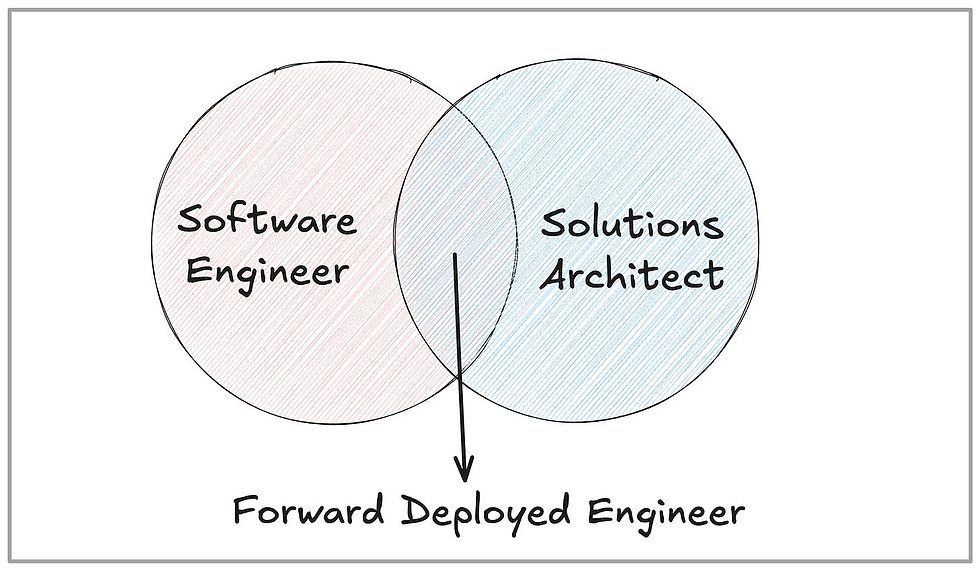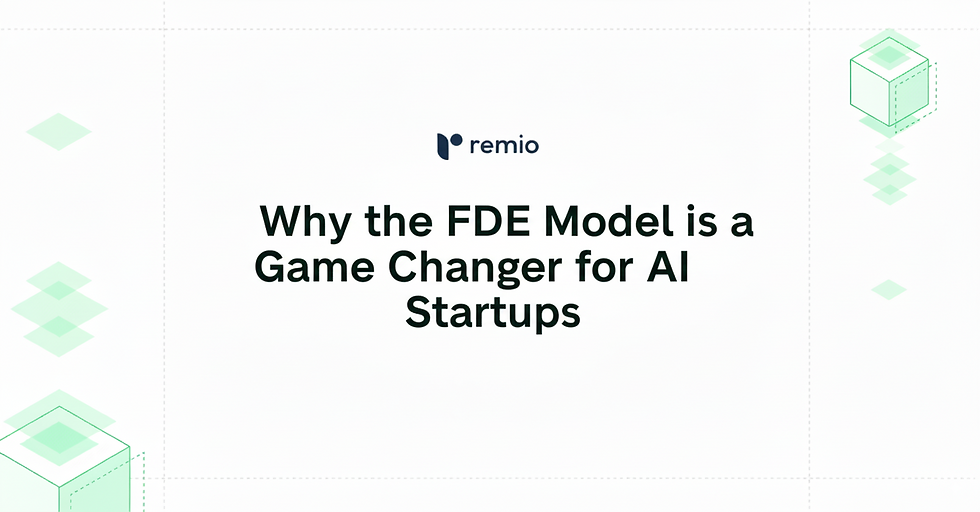The Forward Deployed Engineer (FDE) Model: A Strategic Playbook for AI Startup Success
- Olivia Johnson

- Sep 22
- 8 min read

Introduction: Bridging the Gap Between AI Innovation and Real-World Impact
In today's rapidly evolving technological landscape, particularly within Artificial Intelligence, successful product development demands more than just ingenious ideas. It requires a dynamic strategy to connect cutting-edge innovation with tangible customer value. This article explores the Forward Deployed Engineer (FDE) Model, an increasingly vital approach for AI startups seeking to transform breakthrough technologies into indispensable solutions. The FDE Model, championed by pioneers like Palantir and now embraced by the burgeoning AI agent sector, offers a unique playbook for deep product discovery, rapid iteration, and sustained growth in complex, underserved markets.
Unpacking the FDE Model's Foundational Principles

The Essential Role of a Forward Deployed Engineer
At its core, a Forward Deployed Engineer is a highly technical individual, often an engineer, who operates directly at the customer's site. Their fundamental mission is to bridge the gap between what a product currently offers and the specific, often unarticulated, needs of the customer. This isn't just about selling; it's about deeply embedding to understand and solve complex problems. Bob McGrew, an early executive at Palantir and former Chief Research Officer at OpenAI, highlights that the FDE Model is effectively "doing things that don't scale at scale" – an acknowledgment that initial, high-touch efforts are essential for profound product discovery. For AI agent companies, where incumbent products are scarce and product discovery is paramount, this model is proving to be a critical accelerant for innovation and market fit.
The Genesis of the FDE Model: Lessons from Palantir's Early Days
The FDE Model didn't emerge from a conventional business textbook; it was born out of necessity at Palantir. When building software for the intelligence community, Palantir faced a unique challenge: their target users—spies—were notoriously difficult to engage for traditional product requirements gathering. Instead, Palantir adopted an iterative, demo-driven approach. They would build a basic demonstration, present it to potential customers, absorb their feedback ("This is terrible. This isn't related to what we do at all."), and rapidly iterate.
This hands-on discovery process diverged sharply from the conventional wisdom of "Crossing the Chasm" strategies, which advise scaling rapidly by treating all customers uniformly once product-market fit is achieved. Palantir discovered that their customers' needs were always "slightly different at every place". This heterogeneity demanded a platform-like product capable of deep, on-site customization, fundamentally giving rise to the FDE strategy.
Deconstructing the Operational Blueprint of the FDE Model
The Two Pillars: Echo and Delta Teams in the FDE Model
The Echo Team: These embedded analysts act as on-site product detectives. They immerse themselves in the customer's environment, speaking directly with users to identify critical problems and determine the most impactful use cases for the product. Beyond discovery, they also serve as account managers, nurturing key customer relationships.
The Delta Team: Comprising highly skilled software engineers, the Delta Team is responsible for rapid prototyping and solution deployment. They take the insights from the Echo Team and quickly build functional prototypes—sometimes rough-and-ready code—to deliver immediate value to the customer.
This collaborative structure allows for an incredibly swift cycle of problem identification, solution development, and on-site deployment, often within a few months, demonstrating tangible progress to leadership.
Crafting the Ideal FDE Team: Cultivating Profiles for Success
Recruiting the right talent is paramount for the FDE Model. The profiles differ significantly from traditional roles:
Echo Team Characteristics: Ideal Echo team members possess deep domain knowledge, often coming from the customer's industry (e.g., former army officers for defense, healthcare professionals for medical sectors). Crucially, they must be "rebels" or "heretics"—individuals who understand existing processes but recognize their inefficiencies, seeking a 3x or 10x improvement through new software.
Delta Team Attributes: Delta engineers excel at prototyping and delivering outcomes rapidly. They are not "craftsmen" focused on building perfectly maintainable code for decades, but rather pragmatists who can quickly write code to solve immediate problems. The initial version might even be discarded later, but its value lies in proving the concept and delivering a tangible result.
Bob McGrew notes that these roles, particularly the FDE role, often resemble that of a startup founder, providing excellent training for entrepreneurship.
Strategic Advantages and Business Mechanics of the FDE Model

Moving Beyond Traditional Consulting: The FDE Business Model
The FDE Model is frequently mischaracterized as mere consulting. While it involves high-touch customer engagement, its underlying business model is fundamentally different. Unlike traditional consulting, which aims to minimize work per customer, the FDE approach is designed for product discovery and long-term, scalable value creation.
Initially, a new customer deployment might incur losses. However, as the product evolves to better suit customer needs through FDE feedback, and as the company gains access to more significant problems within the enterprise, the cost per delivered outcome decreases. Profit margins, initially negative, become positive over time, typically within a year or a few years. This trajectory demonstrates a repeatable, product-centric value delivery system, distinguishing it from pure services.
The Product Team's Vital Role in the FDE Ecosystem
The core product team plays an indispensable role in the FDE Model, acting as the generalization engine. While FDEs solve specific customer problems on the ground, the product team's responsibility is to "hold the product vision". They must analyze individual FDE implementations and abstract them into generalizable features that will benefit multiple future customers. This process transforms a "gravel road" (a specific FDE solution) into a "paved superhighway" (a scalable product feature).
A classic example from Palantir is the invention of its ontology. Instead of creating distinct database tables for "people" or "money," the product team generalized these into abstract concepts like "objects," "properties," and "links," allowing FDEs to define specific types per customer while maintaining a unified, flexible platform. This abstraction, however, often creates healthy cultural tension between FDEs (focused on immediate customer needs) and the product team (focused on generalization), highlighting the importance of aligning incentives.
Why the FDE Model is a Game Changer for AI Startups

Navigating the Uncharted Waters of AI Agents with the FDE Model
The FDE Model's resurgence is particularly pronounced in the AI agent market for several compelling reasons:
No Incumbent Product: Unlike traditional SaaS, where a new product might replace an existing one, AI agents often inhabit entirely new market categories. This lack of precedent necessitates extensive product discovery to understand what users truly need.
High Heterogeneity: The AI market, much like Palantir's early defense market, is characterized by diverse user needs and workflows. An AI agent designed for one specific task might require significant adaptation for another, even within the same broad industry. The FDE Model allows startups to navigate this "incredible heterogeneity" by "doing things that don't scale at scale" for each segment.
Deep Product Discovery: The complexity of AI solutions means that understanding their true value requires direct, embedded interaction with customers. FDEs enable this deep dive, uncovering novel applications and refining product offerings that would be impossible through remote development alone.
Measuring Success: Pricing Outcomes and Leveraging Product in the FDE Model
In the FDE Model, the metrics for success diverge from traditional SaaS. Instead of focusing on usage, subscriptions, or seats, pricing shifts to the outcome and value delivered to the customer. This means actively working to "drive the contract size up" by delivering increasingly valuable work, rather than just driving down the cost of customer acquisition or support.
Another critical metric is product leverage. As the FDE Model matures, the central product should provide more leverage to the FDEs , allowing them to deliver greater value with less custom work per engagement. This iterative improvement is often facilitated by demo-driven development. By repeatedly showcasing the product's capabilities in real-world scenarios, companies can create "desire" in customers and force internal teams to ensure features work cohesively and address genuine pain points, refining the product for broader appeal.
Challenges and Future Outlook for the FDE Model
Common Pitfalls and How to Overcome Them
Implementing the FDE Model is not without its challenges. Founders must be vigilant to avoid several common pitfalls:
Avoiding the Consulting Trap: The most significant risk is devolving into a pure consulting firm, building one-off solutions without generalizable product growth. Organizational discipline is crucial to ensure FDEs focus on problems that drive valuable, repeatable product improvements , not just easy requests.
Securing Executive Buy-in and Navigating Internal Politics: Deploying into large enterprises often means confronting internal IT teams and complex organizational structures. Success hinges on securing high-level executive buy-in, ensuring the FDE is addressing one of the "CEO's top five problems" to gain the necessary authority to operate and overcome bureaucratic hurdles.
The Need for Experienced Leadership: Many successful FDE implementations benefit from leadership with prior experience in this model, often from Palantir alumni , as it requires a distinct understanding of choosing problems and pricing outcomes. However, the skills can be learned and cultivated.
The FDE Model: A Catalyst for Continuous Learning and Innovation
Ultimately, the FDE Model fosters a culture of continuous learning and adaptation, crucial for success in dynamic fields like AI. The constant interaction with diverse customer environments compels both FDE and product teams to evolve their understanding of market needs and product capabilities.
Bob McGrew observes that despite rapid advancements in AI capabilities, adoption often lags significantly. This "gap" between technological potential and real-world utility represents a massive opportunity for the FDE Model. Startups acting as FDEs to larger AI developers (like OpenAI) can bridge this divide , transforming raw AI power into genuinely useful, adopted solutions. This continuous "grinding motion" of problem-solving and adaptation is what makes the FDE Model a powerful engine for innovation and a viable path to success in the AI era.
FAQ: Deep Dive into the Forward Deployed Engineer Model

Q1: What exactly is a Forward Deployed Engineer (FDE) and what do they do?
An FDE is a highly technical individual, typically an engineer, who works directly at a customer's site. Their primary role is to identify and address the gap between a product's current functionality and the customer's specific needs, driving product discovery and delivering tangible outcomes.
Q2: How does the FDE model differ significantly from traditional software consulting services?
While both involve on-site work, the FDE Model focuses on productizing solutions rather than custom service delivery. FDE aims to abstract specific customer needs into generalizable product features, leading to repeatable value and increasing product leverage over time. Traditional consulting typically maximizes billable hours for bespoke solutions.
Q3: Why has the FDE model become particularly vital for AI startups compared to traditional SaaS?
The FDE model thrives in new, uncharted markets. For AI startups, there are often no incumbent products, and the market is highly heterogeneous, requiring extensive on-site product discovery to define what AI agents should truly do and how they should function in diverse contexts.
Q4: What are the distinct roles within an FDE team, specifically the Echo and Delta teams?
The Echo Team comprises embedded analysts who identify customer problems, understand user needs, and manage relationships. The Delta Team consists of engineers focused on rapidly prototyping and deploying software solutions to address those identified needs.
Q5: How should AI startups using the FDE model approach pricing their solutions?
Instead of pricing based on usage, subscriptions, or seats (common in SaaS), FDE pricing often centers on the "outcome" or "value delivered" to the customer. The goal is to drive the contract size up by delivering increasingly valuable work, often with initial deployments incurring losses that turn profitable over time.
Q6: What are the primary challenges or risks associated with implementing an FDE strategy?
Key challenges include the risk of becoming a pure consulting firm, failing to generalize specific solutions into scalable product features. Other hurdles involve securing executive buy-in within large client organizations and overcoming internal IT resistance to deploying new technologies.
Q7: Can the FDE model be effectively applied to industries beyond defense and AI?
While its origins are in defense (Palantir) and it's currently popular in AI, the FDE model is relevant wherever there's a need for deep product discovery in complex, heterogeneous markets with no clear incumbent solutions. It's particularly useful for entirely new product categories that require significant adaptation to customer environments.
Q8: How does the core product development team integrate with and support the FDE strategy?
The core product team is crucial for generalizing the insights from FDEs. They analyze the specific solutions developed for individual customers and abstract them into core product features and platform capabilities that can be reused and scaled across a wider customer base.
Q9: What does the future hold for the FDE model as AI capabilities continue to advance rapidly?
The FDE model is likely to become even more critical. With AI capabilities evolving at an unprecedented pace, there's a growing "gap" between what the technology can do and what customers are ready to adopt. FDEs are uniquely positioned to bridge this gap, translating advanced AI research into practical, user-centric applications and fostering a continuous learning environment within companies.


